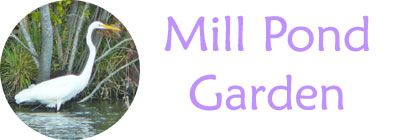Garden Open Day, Sunday November 13, 2022 from 10 AM to 1 PM
13nov10:00 am1:00 pmGarden Open Day, Sunday November 13, 2022 from 10 AM to 1 PM
Event Details
Enjoy Outstanding Fall Color for Cape at Mill Pond Gardens One ticket admits one vehicle with up to 6 passengers. Tickets are non-refundable and can be given as a gift The secret
Event Details
Enjoy Outstanding Fall Color for Cape at Mill Pond Gardens
One ticket admits one vehicle with up to 6 passengers. Tickets are non-refundable and can be given as a gift
The secret to good fall color display is not just lots of color, but colors that set each other off to great advantage. Select plants that provide these contrasts among choice perennials, shrubs, and trees. Second step is to plan for an extended autumnal display of color, one that is not over in a few days, but that lasts a few weeks. Select plants providing color at different stages of fall for a progression of color to lengthen the season of color from late October to mid-November. One good garden design tip is to open vistas from your garden into nearby gardens and natural views with fall color.
Perennials for outstanding fall color include native Amsonia, Little Blue Stem native prairie grass, and late blooming perennials like hardy chrysanthemums, native mist flower, Salvias, and Ligularia.
Colorful shrubs for the Cape include fall blooming Camellias for both the dark shiny evergreen leaves, and for the gorgeous fall flowers in pinks, white, reds, and purples, in great profusion from about late October to early January. Though non-native, Camellias do well in Delaware and are highly beneficial to our 200 native be species to tide them into winter hibernation, and for overwintering or late migrating hummingbirds. A favorite of Mill Pond Garden is Abelia Rose Creek, an all year round outstanding performer whose best look is it s fall production of huge clusters of rosy sepals that last for months of show.
Tree foliage provides the biggest bang of color for autumn. For tree color Mill Pond Garden recommends the choicest Sorrel Tree (the best), Black Gum Nyssa Autumn Cascades, Dogwoods with pink flowers (because they have more colorful foliage than white flowered ones), Serviceberry Autumn Brilliance, Japanese Maple Viridis (best), and native Sweet Gum which you must choose as a sapling when in fall color because they are unpredictable and can be either dull fall foliage all their life or richly colored and every shade of colorfulness in between due to genetic variation. It is recommended to choose a wild seedling that shows good reds, purples, and oranges as a seedling. With permission from property owner, you might dig up such a colorful seedling and transplant it to the back of your garden border. Or if you shop a nursery for a Sweet Gum tree (Liquidambar is botanical name), choose it in late October when its colorfulness quotient is evident. Don’t group all the yellow trees together or the red or orange together, but alternate the strong colors for a more lively contrast effect, a thrill in fact, as is the fall color display at Mill Pond Garden. Other good fall foliage trees for the cape area include some Red Maple, Sugar Maple, and Sassafras. The colorfulness of the red maples is also a matter of genetic variation so choose one when leaf color is evident in fall.
For colorful shrubs choose native Devils Club, Sumac, and Chokeberry. There are other shrubs like Smoke-bush and Fothergilla, but they are very temperamental about location and may fail if not perfectly suited to site. Some non-native ornamental shrubs also can provide great foliage color including some cultivars of Crepe myrtle It is always best for fall leaf color display to be seen with abundant evergreens present to set them off handsomely.
Fall is not just about leaf color. Besides leaves, for flower color in fall there are the glorious fall shrubs that provide great berry color, especially the native deciduous hollies, but also Crabapple and Hawthorne with abundant color of orange to red berries for not only looks but also to feed birds through winter.
Camellias are evergreens that have been in Cape gardens for a long time, under-used in local gardens. There are new hybrid cultivars available for larger flowers, more colors, and all winter blooms. No shrub adds more to a landscape than a Camellia. Camellias are perfect for the Cape, preferring part shade, growing about a foot per year, liking good drainage and compost enriched soils. Fertilize them with an organic fertilizer for Camellias, especially horse manure, in late winter and again in late summer. Camellias in this country are known to live more than two hundred years. They help sustain hummingbirds and bumble bees in winter as well as cheer the eye on a bright winter day.
Mill Pond garden grows many Camellias with flowers constantly from October to June, recommending the following cultivar names: Kanjiro, Winter Star, Kramer’s Supreme, Black Tie, Londontowne Blush, April Tryst, Debutante, Yuletide, Setsugekka, Tom Knudsen, Kramer’s Beauty, Mrs. Lyman Clarke, In the Pink, Camellia sinensis, and Christmas Beauty. Tea can be made from fresh Camellia leaves! For their dense foliage protection birds like to shelter from bad weather in Camellias.
more
Health Guidelines for this Event
Time
November 13, 2022 10:00 am - 1:00 pm(GMT-04:00)
